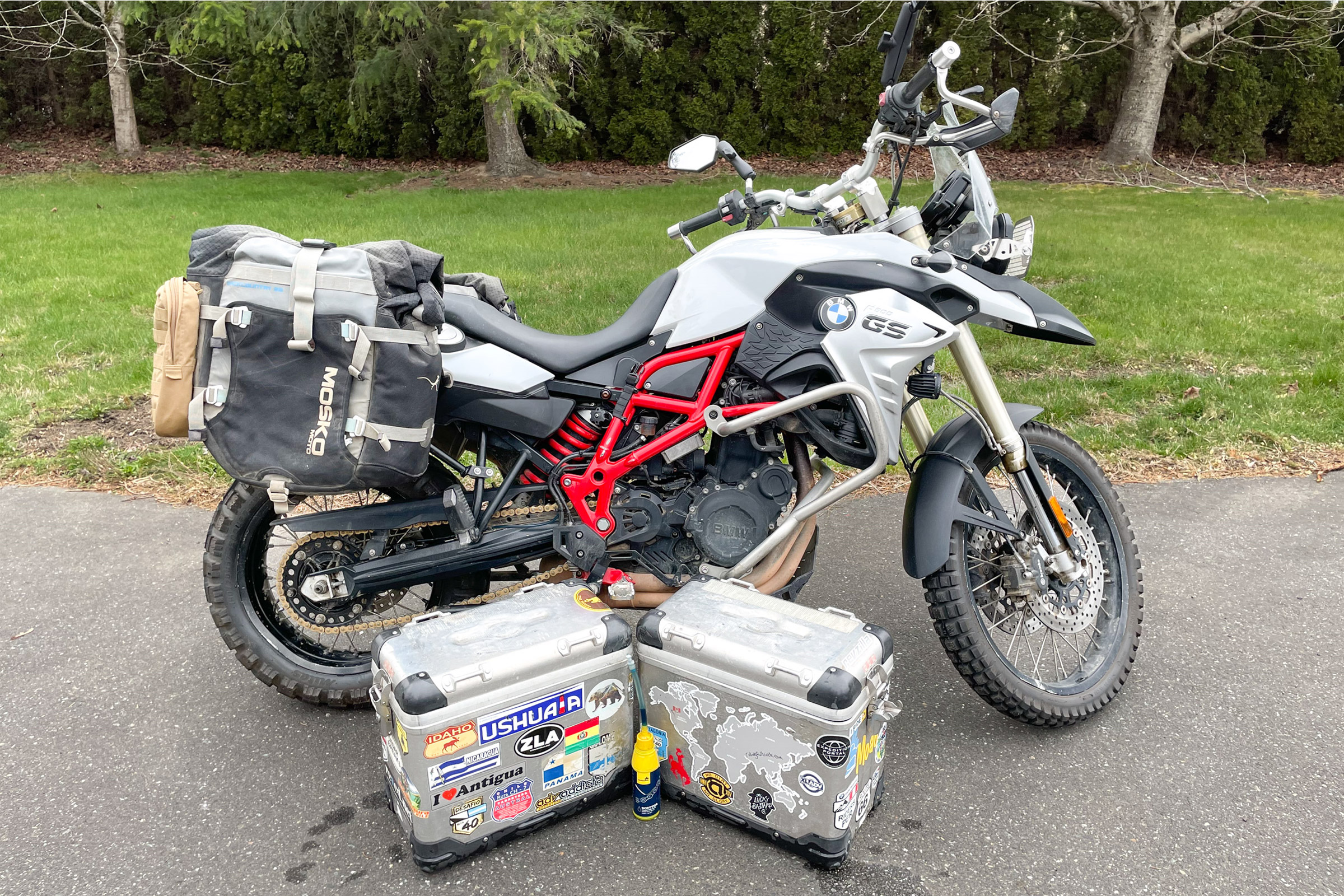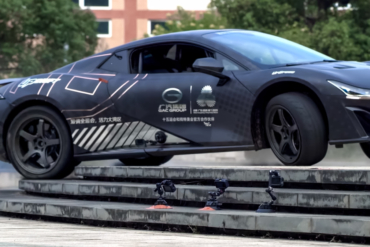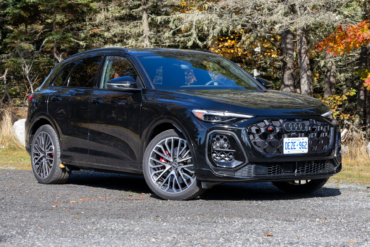There are many factors involved in finding something that will store all the gear needed for your adventure motorcycle travels, yet is functional, secure, and weather-resistant. Sure, you can strap a backpack to the rear seat, or even wear it, but I guarantee that on long trips spanning a few hundred miles or more, your shoulders and lower back will hate you.
And if you’re doing anything exciting — like getting off pavement — it doesn’t matter how well you think you’ve strapped down that backpack or duffel, you’ll find it slid down the side of your bike, if you even find it at all.
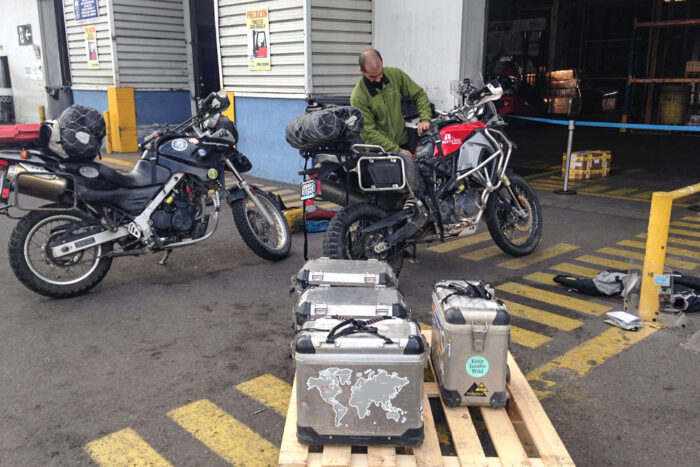
Of major importance is that you can easily remove whatever luggage system you opt for. This is something you might not think about until you’ve pulled up late at a hotel in the rain and you’re starving. Do you really want to pull out tools to take your luggage indoors? Probably not.
Things to Consider When Choosing Motorcycle Luggage
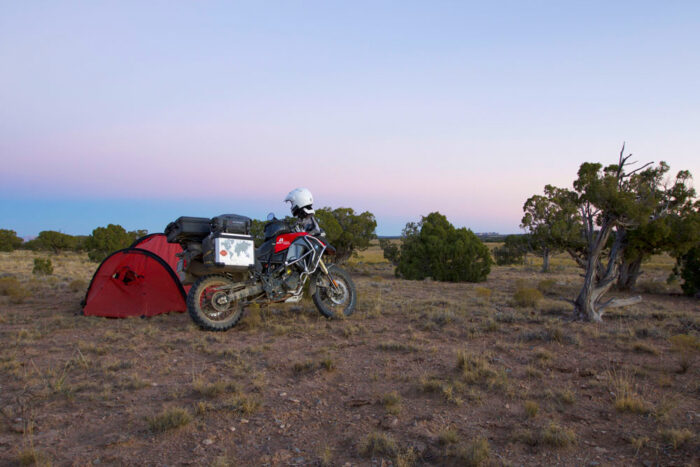
Keep in mind weight distribution. It’s best to have luggage strapped down low for a better center of gravity. If you’re still thinking about the backpack/duffel bag option, remember that might become problematic on more technical terrain if you’re top-heavy.
Other considerations: do you want your luggage to be waterproof, removable, lockable, lightweight, or rackless…? What type of road surfaces will you ride? Anything off-pavement will need something bombproof that stays tight to the bike.
All these factors are important in choosing the right luggage for your travels. But you’ll likely have to compromise on something.
For example, soft bags are usually lighter but are difficult to lock up when away from your bike. Hard cases are easy to lock up, but a pain to remove.
Luggage Racks
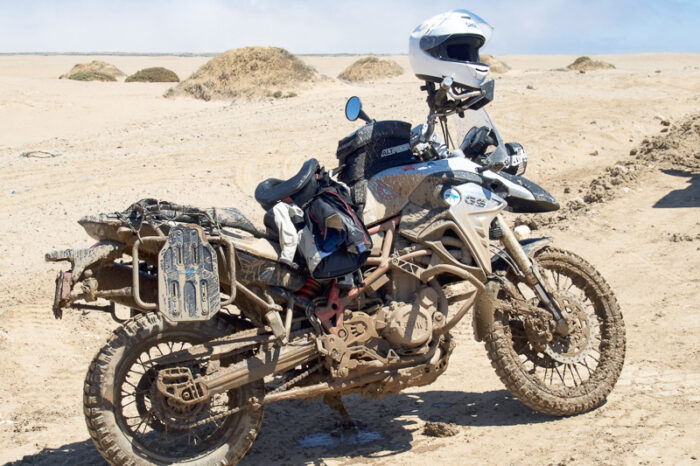
Don’t forget that most bags and all cases need a rack installed on the bike’s frame for securing them to your steed.
Manufacturers may sell racks to go with their luggage system, but it’s usually an added expense on top of the luggage itself.
Many racks will fit more than one type of luggage. For example, my former luggage rack fit both hard cases and soft panniers. In some cases, you may need to be handy with alterations.
A solution for those going super light — and without a pillion — are rackless soft bags. These usually wrap over the passenger seat and clip to the frame, so they don’t bounce around.
When looking for luggage, almost every manufacturer site or retailer will have a link included as to what rack fits that style of luggage and where to buy it.
Strapping It All Down
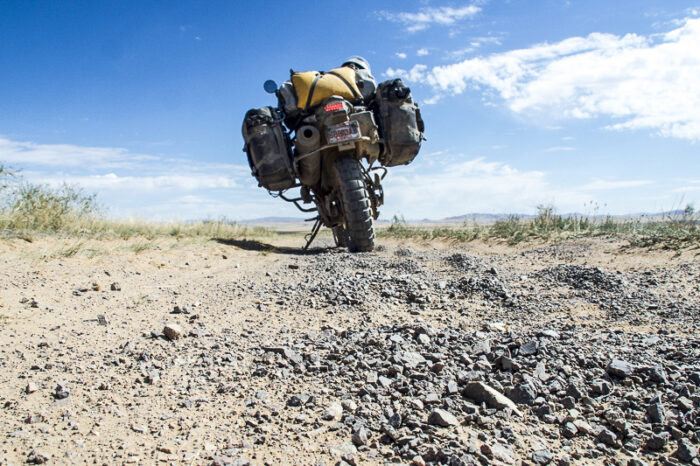
I highly recommend avoiding bungee cords at all costs. There’s a reason why you see them littering the roadside. These guys easily come unhooked when tension/loads fluctuate.
Search online for adjustable compression straps. You’ll want something that can adjust as the load fluctuates but has a secure buckle so they can’t move or come unclipped. I like ROK straps.
Pros & Cons: Soft Bags
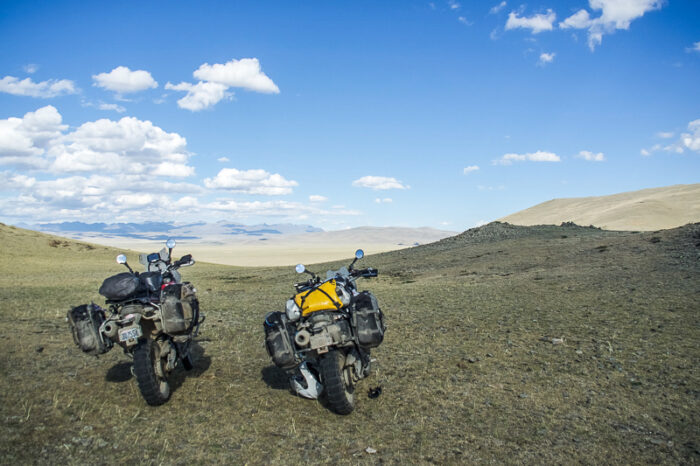
My personal choice for moto luggage is soft bags. I like how they look and they’re almost always lighter. Removal ease is also a huge plus.
Although they’re made from soft fabric — like vinyl, nylon, and/or Hypalon — I find soft bags far more durable than aluminum. Hard cases can bend or dent, which will affect how the lid closes, allowing water inside.
I’ve crashed on a gravel road doing 55 mph with soft bags. Not only did the panniers stay on — likely because they absorbed some of the impact — they also escaped with just a few scratches that didn’t even penetrate to the second layer.
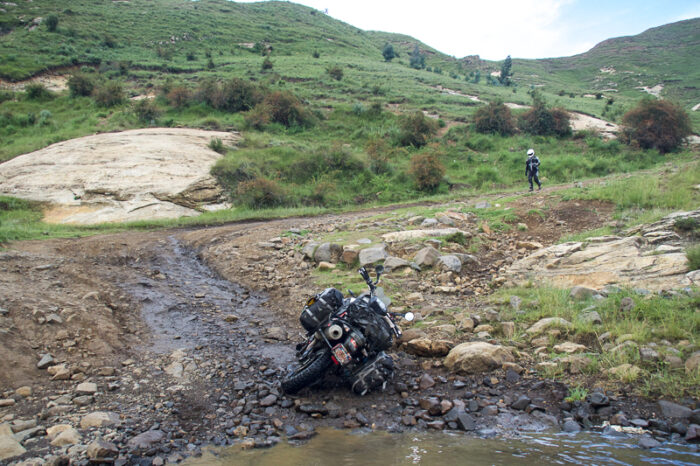
Soft bags do squish, however, and if you go down, items inside could break. Carry things like cameras, laptops, and booze bottles in a waterproof bag on the rear seat, remembering to keep heavier items down low when possible.
Soft Bags: Pros
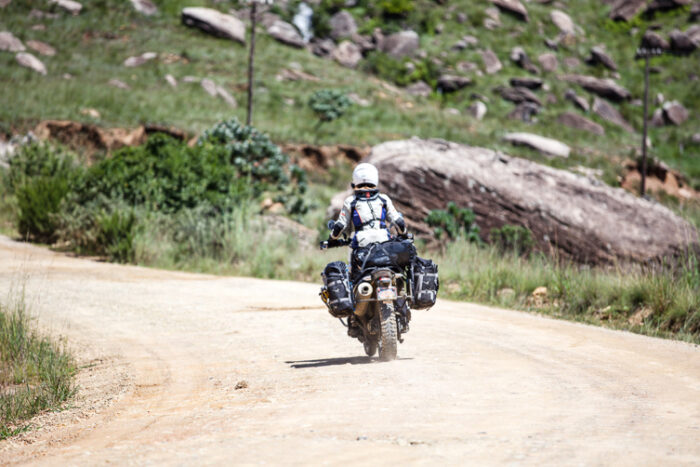
- Waterproof (purchasing additional dry/liner bags may be required)
- Softer for absorbing impacts
- More choices than hard cases
- Can come with auxiliary bags (add for extra storage; remove when not needed)
- Volume can fluctuate for more or less gear
- No keys required
- Lighter (rackless as low as 3 pounds)
- Easier to remove and carry indoors
- Lower profile, not as wide as hard cases
- Less detrimental outcome when bags hit in the back of the leg/ankle
Soft Bags: Cons
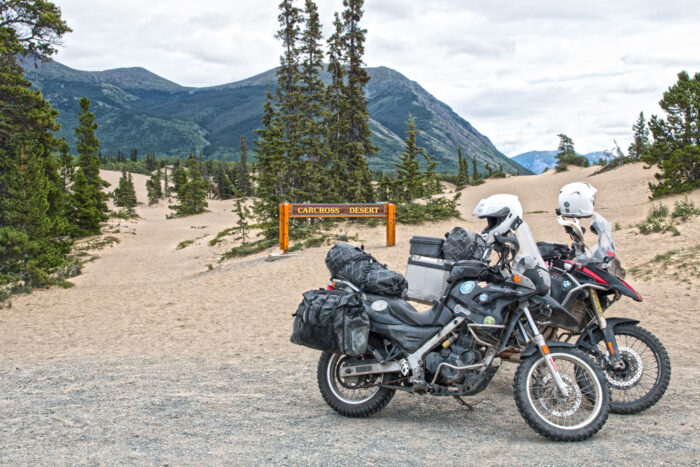
- Not lockable/secure (I use an anti-theft protector)
- Some brands have too many straps that can flap around when riding
- Breakable items are not as protected
- Hard to see into; smaller openings at the top
- Additional dry bags may be required to ensure water-resistance
- Low-quality soft bags are easily destroyed
- Squishy with less leverage for picking up the bike
- No room for stickers 🙁
Pros & Cons: Hard Cases

There are many reasons to vote for hard case luggage, but one of the worst crashes I had was with a bike sporting aluminum panniers. I tagged a boulder and lost control, landing in a ditch and breaking my wrist.
Although much of that was due to rider error (I didn’t give myself enough space to pass the rock), soft bags would have absorbed the impact better, and I might have stayed upright.
Hard cases work great — when they’re not damaged. The minute your bike lays down on top of a rock, the case is now bent, which can affect the way its lid closes.
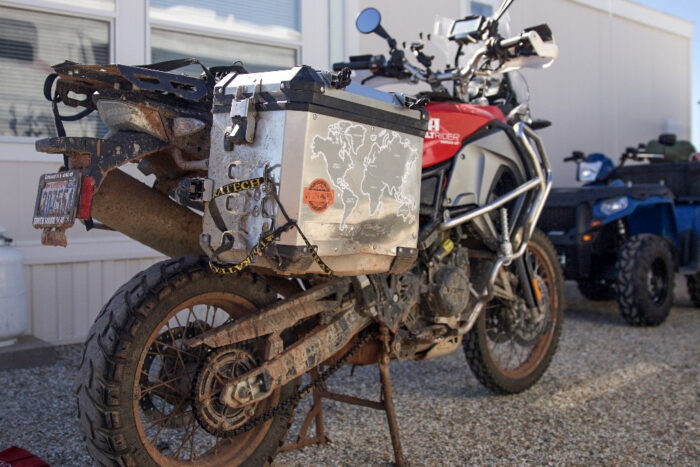
This happened to my husband after dropping his bike. Although he pounded out the dent, the lid never closed properly again, and water always found its way inside.
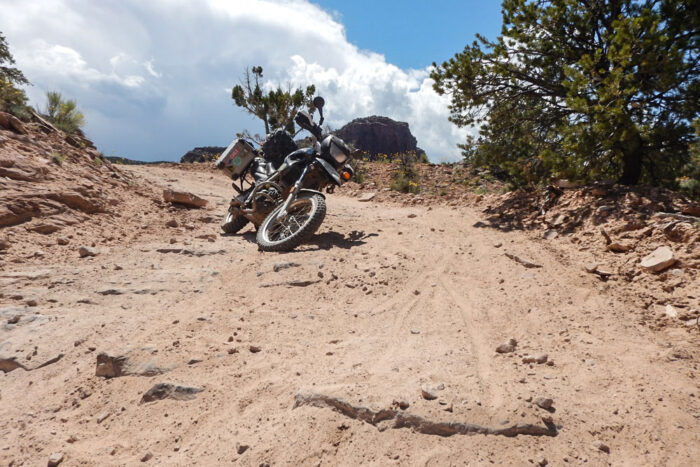
Speaking of dropping bikes, hard cases don’t compact so they tend to keep the bike higher, at an easier angle to lift from. Soft bags crush and “lower” the bike, giving a steeper angle.
All that said, hard cases are far better than soft bags when it comes to avoiding theft.
Hard Case: Pros
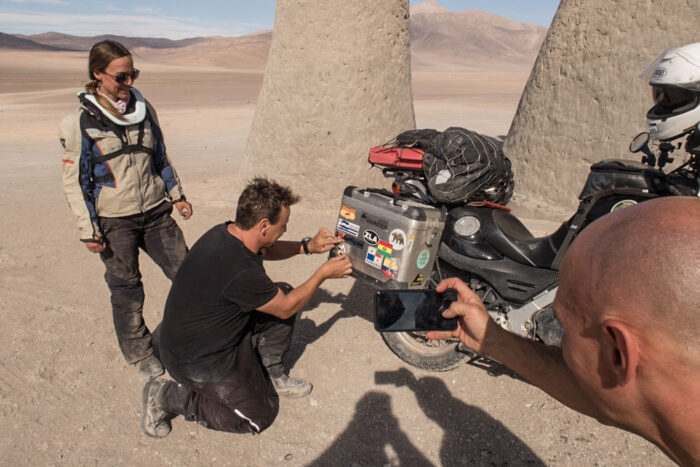
- Lockable/secure
- Watertight (when not damaged)
- Hard outer shell protects items inside better
- Large lids open out of your way, easy access
- Easier to lift bike when on its side
- Great for sticker collecting
- When removed, cases make a solid seat or table
- Solid tops are also great for strapping on extra luggage
Hard Case: Cons
- “Hippy” — a little on the wide side
- Limited choices from manufacturers
- Easy to lose or damage keys
- Locks can get packed with grit
- Greater kinetic energy when hitting something
- Cases tend to hit off-roaders in the legs and ankles
- Water-resistance issues when damaged
- Difficult to remove
- Heavy (up to 15 lbs.)
- Requires more hardware
- Volume is not adjustable
I’ve used Zega Pro panniers and BMW-branded cases.
Hard Cases vs. Soft Bags: Summary & Cost

As you can see, each luggage style can make its own case (see what I did there?) for what might be better on long moto trips. There is no clear winner cost-wise, and both hard cases and soft bags are roughly the same price — expensive.
The choice is up to you. Decide what style of riding you’re doing, where you’ll be traveling, and if security is an issue.
Try to buy the best rack and luggage system you can afford. Endless miles of washboard roads — and high-speed highway trips — can vibrate hardware loose from its fittings. Losing a pannier on the interstate, or up a backroad you can’t find again, will ruin your day.
Hard cases can cost $800-1,400 and up per pair, not including a rack. Soft bags can cost between $200 and $600 for rackless bags, and $550-1,300 and up, not including a rack, for pannier-style bags. Racks can cost between $250-500 and up.
